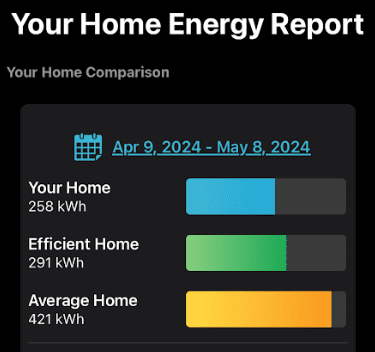Improving home energy efficiency truly pays off. Not only does it benefit the environment, but it also helps you cut down on hefty bills over time. With a few simple upgrades and adjustments, you can reduce your energy bills while also lowering your home’s carbon footprint.
Home energy efficiency upgrades pay for themselves in time and have many other benefits for the homeowner looking to go green when improving their living space. Simple changes like switching to LED bulbs can make a huge difference in your quest to make your home eco-friendly and help reduce utility bills. With the rise in integrating energy-saving smart home gadgets like automated lighting systems and smart plugs, it has been very easy to keep your home energy-efficient.
Pro Tip: Most power companies send out a monthly or quarterly energy report that compares how efficient you are compared to households of the same size in your neighborhood. Check this regularly, as it frequently gives tips on where you can save a few dollars!

Here are some of the changes I’ve made over the years to reach my energy savings goals. Trying just a few of these could help you save hundreds of dollars each year—and as a bonus, you’ll be doing your part to help the planet too!
I may earn a small commission via affiliate links in this post. This is at no extra cost to you! Read the full disclosure here.
Conducting a Home Energy Audit (Foundation for Energy Savings)
Total Cost: $0
Before you begin to make your home energy-efficient, getting a prior energy audit on your home is really critical. They will target specific areas in the house where you waste the most energy consumption, and then you can implement changes to boost your savings.
Contact your power company and ask if they provide this service free. Most companies do and will inspect your home for potential savings. Their recommendations may include any or all of the following:
- Analyze your total home energy usage.
- Check for air leaks.
- Examine insulation levels.
- Review appliances and heating/cooling systems.
While consulting an expert is always ideal, you can also perform your own here
Top Ways to Boost Your Home Energy Efficiency
The following are some key steps in home energy efficiency that could help to greatly reduce your energy bills while also helping the environment.

Boosting Home Energy Efficiency with Insulation and Air Sealing
Insulation is one of the most effective ways to achieve an energy-efficient home.
Proper insulation will regulate your home’s temperature and prevent extreme heating and cooling. Sealing drafts in a house and insulating its walls, floors, and attics can maintain the comfort of the house throughout the year with a much lesser quantity of energy used by the owner.
Check for Air Leaks
Total Cost: Under $100 depending on the size of your house
If you take advantage of a home energy audit we talked about earlier, you’ll just need to execute what they suggest to maximize your energy savings. If not, just answer the questions below.
- Do your doors seal all the way? Can you see sunlight through them during the day?
- Can you feel the air around the windows and doors?
- Are the pipes on your external walls sealed completely?
- Can you feel drafts coming from the light sockets on your external walls?
These are all cheap and simple fixes with the addition of weather stripping and adding insulation where needed. You can even pick up socket sealers at most hardware stores for under $10 for a pack of 24.
Sealing leaks and adding insulation can save up to 10% annually on your energy bill.
Enhance Home Energy Efficiency with Energy-Efficient Appliances
Total Cost: $300+ depending on the appliance
Another highly relevant method of making your house energy efficient is by using energy-saving appliances. These could yield significant savings through decreasing electricity bills as time progresses by upgrading to high-rated Energy Star appliances.
These appliances are designed to work more efficiently with less energy and higher performance. There are tons of options for appliances like refrigerators, washing machines, heaters, and HVACs that decrease your energy consumption at home and save money in return.
Improve Home Energy Efficiency with Smart Home Devices
Smart home devices have revolutionized the way we manage our energy usage at home. Smart thermostats are one of the simplest and most effective ways to optimize the efficiency of your heating and cooling systems.
These devices eventually learn your habits and automatically make changes to settings for the purpose of ensuring that as little energy as possible is wasted. You can even control them remotely with your smartphone to save energy when you are out of your house.
Programmable Thermostat
Total Cost: $50 average
According to Energy.com, it’s possible to save almost 10% by adjusting your thermostat 7-10 degrees for 8 hours a day. The link provided takes a deep dive into what to consider for your situation.
You can still do this manually if you don’t have a programmable thermostat. Make it a habit or set a reminder to change it before you leave the house or go to bed.
Smart or LED Lighting
Total Cost: $10+ depending on the option chosen
Another impressive smart home gadget for saving energy is smart lighting. When you replace regular bulbs with smart energy-efficient LEDs and hook them up to a smart lighting system, this allows you to control lights from your phone. Now you can flip those lights on and off remotely to save some energy while gaining that little bit extra comfort factor in your day.
Now take it a step forward, if you can, to fit all your in-wall motion sensors into this lighting scenario and have lights turn only as needed to cut further electrical waste.
Don’t want to invest in smart products just yet? Simply upgrading to LED light bulbs can still make a difference.
Install Solar Panels to Maximize Home Energy Efficiency
You might consider solar panels to make your home even greener. Solar panels produce clean electricity from sunlight, reducing demand for traditional power sources and lowering your utility costs. Although it is extremely costly upfront, there are federal incentives available to help offset the cost. For a clearer picture of your potential monthly savings, visit Solar Estimate.
Home Energy Efficiency with Windows and Doors
Upgrading your windows and doors helps keep warmth inside during winter and cool air in during summer, significantly boosting energy efficiency year-round.
Keep Windows and Doors Closed When Heating and Cooling Home
Total Cost: $0
Not only is it hard on your heating and air units, but it is real money flying out the door. In the words of everybody’s mother ever, “Were you raised in a barn?”

Cost-Effective Home Energy Efficiency Tips for Every Room
There are endless ways to cut utility costs across the home, from Energy Star appliances in the kitchen to smart devices in the living room. Even minor adjustments can have a significant impact. Insulation in the bedrooms can keep room temperatures comfortable throughout the entire year, reducing stress on your HVAC system. Many earth-friendly changes in bathrooms cut water and energy consumption regularly, such as low-flow fixtures. The simple upgrades reduce bills and further create an eco-friendly home over time. Here are just a few easy-to-implement fixes that can make a big difference in your home.

Kitchen
Energy Saving Tips for the Oven
Total Cost: $0
Try to use the oven during the coolest hours in the summer. (Do you really need to bake a cake at 2pm in July?) You can also transition to air-fryer or crockpot recipes during the summer months.
Stop opening the oven! The oven temp can drop by 25 degrees every time it’s opened.
Keeping the door seal clean will also lessen the chance of the heat escaping.
Bathroom
Lower the Temperature on the Water Heater
Total Cost: $0
Factory settings usually set your water heater to 140 degrees Fahrenheit. However, Energy.gov suggests that lowering it to 120 degrees Fahrenheit can save you up to $400 annually on energy costs.
Going on an extended trip? Lower the temperature even further while you are away.
Check your dishwasher specs, as some require 130 degrees, and people with certain auto-immune diseases may need to stay at 140 degrees.
Laundry
Energy Saving Tips for the Washer & Dryer
Total Cost: $0 (new washer/dryer excluded!)
Wash in cold water when possible. According to the American Cleaning Institute, 90% of the energy used when washing clothes is from heating the water.
Always wash full loads. My mother will wash 5 shirts at a time. She says I overfill my loads. It’s a constant back and forth, but according to Energy Star®, washing full loads can save up to 3400 gallons of water a year. You’ll save energy and water costs, but also think of all the time saved!
If you are in the market for new machines, look for ones that are Energy Star® rated. According to Energy.com, they use 35% less water / 25% less energy for the washer and 20% less energy for the dryer.
Use the cool-down cycle if your dryer has one. It dries the clothes with the remaining heat.
Air-dry what you can. Even if you don’t have a clothesline, take advantage of the shower curtain rods in your bathroom. This also extends the life of your clothing.
Always clean the lint filter between uses. Most importantly, this prevents fire but can also help with air circulation.
Energy-Saving Upgrades and ROI (Return on Investment) Estimates

Energy Efficiency Tips for Each Season

Simple DIY Tips for Boosting Home Energy Efficiency on a Budget
Want to save energy on a budget? Here are some free energy-saving habits that are easy to implement and that can really help you lower your monthly bill:
Turn Off Lights When Leaving Rooms
Total Cost: $0
Probably the easiest way to save energy is to make it a habit to turn off lights when you leave your room. This may seem like nothing, but over a period of time the savings will add up. Admittedly, I am terrible at this. My house has very little natural light, and honestly, I just don’t notice sometimes that a lamp is on. But after implementing this one task, I have saved nearly $5 each month. The savings will add up over time.
Example: The average cost for a 60W bulb is $.29/hour. This will vary by local and wattage, but for purposes of the example below, we will use this.
$.29 (cents) x 4 (lights) x 8 (hours) = $9.28/month = $111.36 in potential annual energy savings!
Unplug Devices When Not in Use
Total Cost: $0
Every item plugged into a wall is pulling a small amount of energy, even if it’s turned off. The US Dept of Energy states that 5-10% of residential energy is standby power, meaning it is plugged into a wall in the off position. This can total upwards of $100/year for items NOT IN USE.
Unplug those phone chargers, y’all! The use of power strips would come in handy here too, so you can shut down multiple items at once.
Check Your Power Company’s Rate Schedule
Total Cost: $0
Many utility companies have variable rate schedules in which the electricity is less expensive at times of the day when demand is low. You can save money with absolutely no additional hassle by simply doing laundry or dishes at these times. This might be available to you with a quick call or internet check with your utility company.
Use Curtains to Control Temperature
Total Cost: $0
Curtains can do much more than protect intrusions; they also contribute to indoor temperature regulation. Opening the curtains on windows during sunny parts of the day provides warmth during cooler months and reduces heating loads. During summer, in peak sun hours approaching, keep curtains closed on windows with direct sunshine to help cool your home and reduce demands for air conditioning.
Investing in insulated blackout curtains could help save even more.
Check out these Zero Waste Swaps if you want to learn about more ways to save the planet!
Final Thoughts: Home Energy Savings
In a world where energy costs continue to rise, finding ways to save money on your energy bill is an essential step to cutting expenses. From simple changes in behavior to investing in energy-efficient appliances, there are many strategies that can help you reduce your energy usage and save money in the long run.
When looking at possible energy savings, I try to equate it to annual savings. By saving just $.50 a day, you save $182.50 annually. With my $30/weekly food budget, that equals 6 weeks of groceries!
Related: Read here about how I stick to a $30 weekly budget!
Remember, every dollar you save on your energy bill is a dollar you can save for something else. As Benjamin Franklin famously said, “A penny saved is a penny earned.” So why not act today and start implementing these tips to lower your energy costs?
Frequently Asked Questions (FAQ)
Q: Why is home energy efficiency important for both the environment and my wallet?
A: Enhancing home energy efficiency not only reduces utility bills but also reduces greenhouse gas emissions and conserves valuable resources. It’s a great way to save money while doing something good for the environment.
Q: How does improving energy efficiency in my home reduce my carbon footprint?
A: By using less energy, you decrease the demand on power plants, which results in fewer emissions, ultimately reducing your personal carbon footprint and helping combat climate change.
Q: What is a home energy audit, and why should I consider one?
A: A home energy audit identifies areas where your home may be losing energy, providing a roadmap for upgrades to improve efficiency and save on bills. It’s an essential first step for serious energy savers.
Q: Can I conduct a DIY home energy audit, or should I hire a professional?
A: While a professional audit is comprehensive and detailed, you can also conduct a DIY audit by checking for drafts, inspecting insulation, and assessing appliance efficiency. Many utilities offer free or low-cost audits.
Q: How does insulation and air sealing help with home energy efficiency?
A: Proper insulation and sealing prevent air leaks, keeping warm air in during winter and cool air in during summer, which reduces the need for constant heating or cooling and lowers energy costs.
Q: Are energy-efficient windows and doors worth the investment?
Yes, energy-efficient windows and doors reduce drafts and temperature fluctuations, which increases comfort and decreases energy bills, especially in extreme climates.
Q: How can a programmable thermostat help save on heating and cooling costs?
A: Programmable thermostats automatically adjust temperatures to reduce energy use when you’re away or sleeping, which can lead to substantial savings on heating and cooling costs over time.
Q: What are the most cost-effective energy-saving tips for each room in the house?
A: Simple changes like switching to LED bulbs, using energy-efficient appliances, and adding weather stripping can make a significant impact on energy use in each room.
Q: How do solar panels, heat pumps, and battery storage contribute to energy efficiency?
A: Solar panels generate renewable energy, heat pumps provide efficient heating and cooling, and battery storage optimizes power use, all contributing to reduced energy bills and sustainability.
Q: What are some easy, low-cost DIY projects to improve home energy efficiency?
A: Installing LED bulbs, adding weather stripping, using energy-efficient curtains, and adjusting thermostat settings are easy, affordable projects that can quickly make a difference in energy savings.







